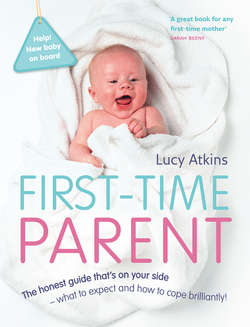Читать книгу First-Time Parent: The honest guide to coping brilliantly and staying sane in your baby’s first year - Lucy Atkins - Страница 51
HOW TO DO PELVIC FLOOR EXERCISES
ОглавлениеImagine you need to stop peeing halfway through: that’s the muscle you’re trying to use.
Clench this, tighten some more, then some more, as if going up three floors in a lift.
Hold it clenched there for about five seconds.
Then release, one ‘floor’ at a time.
Repeat this a few times.
Alternate this exercise with simply doing ten quick squeezes.
Try to make this a regular part of your life from now on by having daily ‘triggers’, such as when you go the loo, or have a drink, or get to a traffic light, or do the washing-up. You’re aiming to do these exercises about ten times every day.
There are other post-birth thrills too. Your bladder control may be practically non-existent in the first forty-eight hours or so, and decidedly dodgy for some time after. The cradle of muscles that supports your bladder and womb has been stretched by the pregnancy and birth and it needs tightening up–this will help your long-term gynaecological health, your ability to hold in pee and your sex life. Start the pelvic floor exercises along the side of this page in the first twenty-four hours. At first you may feel absolutely nothing down there, but twitch away and eventually sensation should return. If you are having any problems with this, or with incontinence, talk to your GP who can refer you to a physiotherapist. Don’t be shy: this is far more common than you’d imagine.
Another delightful and common side-effect down below is piles, or haemorrhoids. These are varicose veins in your bottom that can be sore, itchy, bleed and generally make you feel like your bum has turned inside out. If you suffer from piles, don’t strain to poo, get over-the-counter haemorrhoid treatments, avoid long periods of standing or sitting (lie on your side instead) and try soaking cotton wool in witch hazel and using it as a kind of soothing compress.
Constipation happens to the best of us after childbirth. It is caused by your changing hormones, but pooing a brick full of nails is the last thing you want to contend with after having a baby. So: drink tons of water–keep a jug by your bed–and get your partner to bring you fibre-rich food (hospital food is generally hopeless) like fruit (dried fruit, such as prunes, make a handy snack). When you attempt your first poo after a vaginal birth, try putting a sanitary pad over your vulva and holding firmly. This can seriously help the weird feeling that ‘everything’s falling out’.
Even if you’ve decided not to breastfeed, your boobs will produce a pale liquid called colostrum at first; after a few days they should become swollen and full of ‘normal-looking’ milk. If you are not breastfeeding, use breast pads and a good solid bra and your milk supply will gradually stop.
Talking of emissions–and this is the last one, honest–you’ll also sweat a lot at first to expel the extra fluid your body amassed during pregnancy.
